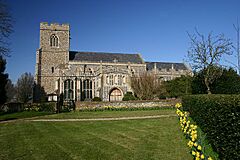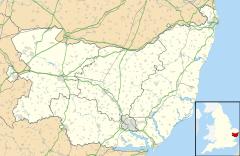Glemsford facts for kids
Quick facts for kids Glemsford |
|
|---|---|
 Parish Church of St Mary |
|
| Population | 3,693 (2021) |
| OS grid reference | TL833482 |
| Civil parish |
|
| District |
|
| Shire county | |
| Region | |
| Country | England |
| Sovereign state | United Kingdom |
| Post town | SUDBURY |
| Postcode district | CO10 |
| Dialling code | 01787 |
| Police | Suffolk |
| Fire | Suffolk |
| Ambulance | East of England |
| EU Parliament | East of England |
| UK Parliament |
|
Glemsford is a village in Suffolk, England. It is located in the Babergh area, close to the town of Sudbury. The village is near the River Glem, and the River Stour also flows nearby. Glemsford is surrounded by farmland and is close to famous Suffolk villages like Lavenham and Long Melford. In 2021, about 3,693 people lived in Glemsford.
Contents
Village History
Glemsford is a very old village. It was first mentioned even before the Norman Conquest in 1066. This was in a special document from King Edward the Confessor around 1051. This document gave land to a place called Ely Abbey.
Glemsford in the Domesday Book
The Domesday Book was a big survey ordered by William the Conqueror in 1086. It recorded details about England. The Domesday Book shows that Glemsford had 40 households. These included villagers, freemen, smallholders, and slaves. The village also had many animals like cattle, pigs, and sheep. There were meadows, woodlands, a mill, and a church.
Important Buildings and People
Glemsford has several interesting old buildings. One is Monks Hall, which is a medieval timber building. People used to say there was a secret tunnel from Monks Hall to the nearby Parish Church of St Mary the Virgin. The story says monks used this tunnel to go to church without mixing with other villagers. Only a small part of this tunnel is left today. Monks Hall is now a private home.
The Parish Church of St Mary the Virgin was built a long time ago, in the early 1300s. The first known church leader, Hugh de Poynton, was recorded in 1302. Inside the church, you can find the Golding Chapel. This chapel was built to remember John Golding, a rich cloth merchant from Glemsford. He lived in Angel House, another timber building next to The Angel pub. John Golding left money for the chapel to be built when he died. Like many old churches, St Mary's Church tower was rebuilt in the 1800s. Glemsford also has a Methodist Church, which was built during the Victorian era.
In the early 1500s, George Cavendish lived in Glemsford. He was a nobleman and worked for Cardinal Thomas Wolsey. After Wolsey died in 1530, George Cavendish came back to Glemsford. In the mid-1550s, he finished writing a book about Cardinal Wolsey's life. This book was published after George Cavendish died in 1562.
Glemsford and the Puritans
In the 1600s, Glemsford and the area around it were very Puritan. Puritans were a group of Christians who wanted to make the Church of England simpler. By 1640, many families from Glemsford moved to America. They went to the Massachusetts Bay Colony as part of a big move called the Great Migration.
The Old Railway Station
Glemsford used to have a railway station. It was on the Stour Valley Railway line, which connected Sudbury and Cambridge. The station opened in the 1860s. It was busiest during the First and Second World Wars. During these wars, the station was bombed because it was used to store ammunition trains. The station closed in 1967. Today, only the old Station House (now a private home), the goods shed (now flats), and one level crossing post remain.
Glemsford is considered a large village for Suffolk. It has many shops and traditional pubs.
How Glemsford is Governed
Glemsford is part of an area called Glemsford and Stanstead. This area is known as an electoral ward. People in an electoral ward vote for their local representatives.
In the past, Glemsford's local government changed a few times. In 1894, it became part of the Melford Rural District. Then, in 1896, it became its own urban district. This urban district was part of West Suffolk. However, in 1935, the urban district was removed. Glemsford became part of the Melford Rural District again. Since 1974, Glemsford has been part of the Babergh district in Suffolk.
Famous People from Glemsford
Many interesting people have connections to Glemsford:
- George Cavendish (1497 - 1562): A writer, famous for writing about Cardinal Thomas Wolsey.
- Edmund Boldero (1608–1679): A clergyman and academic who was the Master of Jesus College, Cambridge.
- William Falkner (died 1682): A religious leader who supported the Church of England.
- Charles Morgan (1678-1736): A clergyman and Master of Clare College.
- Frederick Cradock (1886 – 1943): He was awarded the George Cross for bravery. He tried to save a workmate from an accident involving boiling steam.
- Billie Whitelaw (1932 – 2014): A well-known stage and film actress.
- Jonathan Green: An author and investigative journalist.
- Nigel Balchin: An author and screenwriter who lived at Greyhound House.
- Cassandra Balchin: A women's rights activist who also lived at Greyhound House.
See also
 In Spanish: Glemsford para niños
In Spanish: Glemsford para niños




